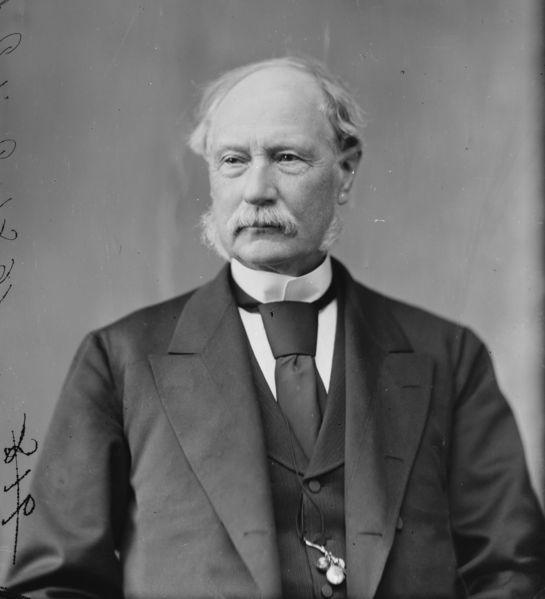<Back to Index>
- Jurist David Dudley Field II, 1805
- Playwright Ion Luca Caragiale, 1852
- Emperor of Japan Jimmu, 711 B.C.
PAGE SPONSOR

David Dudley Field II (February 13, 1805 – April 13, 1894) was an American lawyer and law reformer who made major contributions to the development of American civil procedure. His greatest accomplishment was engineering the move away from common law pleading towards code pleading, which culminated in the enactment of the Field Code in 1850 by the state of New York.
He was born in Haddam, Connecticut. He was the oldest of the eight sons and two daughters of the Rev. David Dudley Field I, a Congregational minister and local historian, and Submit Dickenson Field. He graduated from Williams College in 1825 and settled in New York City, where he studied law. After his admission to the bar in 1828, he rapidly won a high position in his profession.
In 1829, Field married Jane Lucinda Hopkins with whom he had three children: Dudley, Jeanie and Isabella. After his wife's death in 1836, Field remarried twice, first to Harriet Davidson (d. 1864) and second to Mary E. Carr (d. 1874). The eldest child, Dudley Field, followed in his father's footsteps, studying law. He was made a partner in his father's practice in 1854.
Over the next few years he became convinced that the common law in America, and particularly in New York state, needed radical changes in the unification and simplification of its procedure. In 1836, he went to Europe for a thorough investigation of the courts, procedure, and codes of England, France and other countries. He then returned to the US and labored to bring about a codification of its common law procedure.
Several of his siblings also accomplished great things. Among his brothers were Stephen Johnson Field, a U.S. Supreme Court Justice, Cyrus Field the millionaire investor and creator of the Atlantic Cable, and Rev. Henry Martyn Field a prominent clergyman and travel writer. For
more than 40 years, every moment that Field could spare from his
extensive practice was devoted to his codification project. He began by
systematic publication of pamphlets and articles in journals and
magazines outlining his proposed reforms. However, for some years he
met with a discouraging lack of interest. He testified about
codification before successive legislative committees. In 1846, Field
published a pamphlet, "The Reorganization of the Judiciary", which
influenced the New York State Constitutional Convention of
that year to report in favor of a codification of the laws. In 1847 he
finally had a chance to put his ideas into official form when he was
appointed head of a state commission to revise court procedure and
practice. The first part of the commission's work, a portion of the
code of civil procedure, was reported and enacted by the legislature in
1848. By January 1, 1850, the New York state legislature had enacted
the complete Code of Civil Procedure, subsequently known as the Field
Code since it was almost entirely Field's work. The new system abolished the distinction in forms of procedure between an action at law (a civil case demanding monetary damages) and a suit in equity (a
civil case demanding non-monetary damages). Rather than having to file
separate actions, a petitioner could from now on file only one single
action. Eventually Field's civil procedure code was, with some changes,
adopted in 24 states. The new New York state criminal code was adopted
in 18. Both influenced reform in England and several of her colonies. In
1857 Field became chair of another state commission, this time for the
systematic codification of all of New York state law except for those portions already reported upon by the Commissioner of Practice and Pleadings.
In this work he personally prepared almost the whole of the political
and civil codes. The codification, which was completed in February
1865, was adopted only in small part by the state, but it served as a
model after which most of the law codes of the United States were
constructed. In 1866 he proposed to the British National Association for the Promotion of Social Science a revision and codification of the laws of all nations. For an international commission of lawyers he prepared Draft Gistlines of an International Code (1872), the submission of which resulted in the organization of the international Association for the Reform and Codification of the Laws of Nations, of which he became president.
Field was originally an anti - slavery Democrat, and he supported Martin Van Buren in the Free Soil campaign of 1848. He gave his support to the Republican Party in 1856 and to the Lincoln Administration throughout the American Civil War.
After 1876, however, he returned to the Democratic Party, and from
January to March 1877 served out in the US House of Representatives the
unexpired term of Smith Ely,
who had been elected mayor of New York City. During his brief
Congressional career he delivered six speeches (all of which attracted
attention), introduced a bill in regard to the presidential succession,
and appeared before the Electoral Commission in Samuel J. Tilden's interest during the highly controversial presidential election of 1876. He died in New York City in 1894.